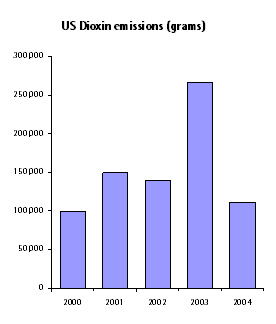Good news about pollution? The US EPA says so. This Washington Post story makes it seem like the US made great strides in reducing toxic emissions in 2004.
The Environmental Protection Agency said Wednesday that chemical pollution released into the environment fell more than 4 percent from 2003 to 2004…The agency said releases of dioxin and dioxin compounds fell 58 percent; mercury and mercury compounds were cut 16 percent; and PCBs went down 92 percent. [Emphasis added.]
Now, the fall in dioxins in particular seemed like pretty big news. But it also struck me as a bit suspicious. So I looked into the numbers a bit.

Then the question becomes—what happened in 2003? Apparently, there was a single wood-preserving facility in Lousiana that was responsible for the 2003 spike. (I don’t know for sure, but I’d guess they landfilled a bunch of contaminated waste.)
So the national “good news” story about dioxins in 2004—a 58 percent decline in releases—turns out to be, if anything, a bad news story about 2003. Or, more properly, it’s an artifact of the way the data are reported: the dioxin “released” in 2003 was likely just transferred from one place to another, in a way that triggered EPA’s reporting requirements.
The thing is, it took just a few minutes to figure out that the EPA’s press release was, at least in part, full of hot air. Obviously, reporters are under tremendous pressure to churn out stories. But I do wish that basic fact-checking was a higher priority for them. Bum facts passed off as “good news” should be recognized for what they are: a form of toxic information pollution.
Closer to home, the news seems a little bit better for dioxin trends. In Washington, Oregon, and Idaho combined, releases to air, water, and land have fallen from 163 grams in 2000 to 46 grams in 2004. “Off-site disposal”—transfers for storage or treatment—has climbed a bit, though. On net, 2004’s total dioxin releases were a bit higher than 2002 and 2003, but have fallen by about a quarter since 2000. And the three states combined now account for about 2 tenths of one percent of national dioxin emissions, as measured by TRI data.
That said, there are some facilities that escape TRI reporting requirements, and much of the dioxin releases from the region are now from activities such as backyard trash burning. But the numbers, for the northwest at least, do seem modestly promising.







